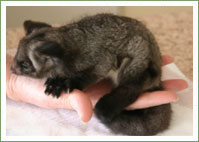Rare rescue of young Greater Glider
Thursday, September 1, 2011

WIRES Central Coast was called to a local vet where this juvenile Greater Glider had been taken by a local resident who had found her on the ground in the Avoca area.
WIRES rescuer, Gary picked her up from the vet and took her home. She was uninjured and Gary thinks she probably fell from her mother's back.
Because Greater gliders are rarely in care it was decided to call in a very experienced carer.
Gordana was called to take her into longer term care.
Although these gliders are not listed as endangered in this area, it is unusual for them to come into WIRES care, especially one that is uninjured like this young female.
She weighs just 150 grams and as you can see fits into the palm of a hand. She will need to be fed three times a day for now and will spend most of her time in her specially made pouch.
Pouches are knitted, sewn and assembled by many dedicated people who provide them to our carers for use with many small mammals in our care. The pattern and instructions for making pouches are on a factsheet for anyone who is interested.
Each year WIRES cares for around four of these very precious native mammals around NSW, mostly in the Clarence Valley area.
The Greater Glider is the largest gliding possum they have thick fur that make them look even larger.
They occur in eucalypt forests and woodlands along the east coast of Australia from north east Queensland to the Central Highlands of Victoria.
These gliders feed only on eucalypt leaves, buds, flowers and mistletoe. They shelter in tree hollows by day and may have many hollows within their home range.
They give birth to a single young in late autumn or early winter which remains in the pouch for 4 months and is independent at 9 months of age. They can glide up to a horizontal distance of 100m.
We are beginning to see an influx of orphaned young as we do in Spring every year. Think about donating to our Spring Appeal to help us be there for young animals such as this very special Greater glider.
Recent Posts
WIRES launches its first wildlife rehabilitation centre - Mullyang
WIRES Emergency Response in the wake of ex-tropical cyclone Alfred
International Women’s Day Volunteer Spotlight: Shelley
Tropical Cyclone Alfred – Emergency Wildlife Advice
Interview with WIRES Training and Development
Celebrating Women in Science: The Journey of Holly, Wildlife Conservationist and WIRES Team Member
